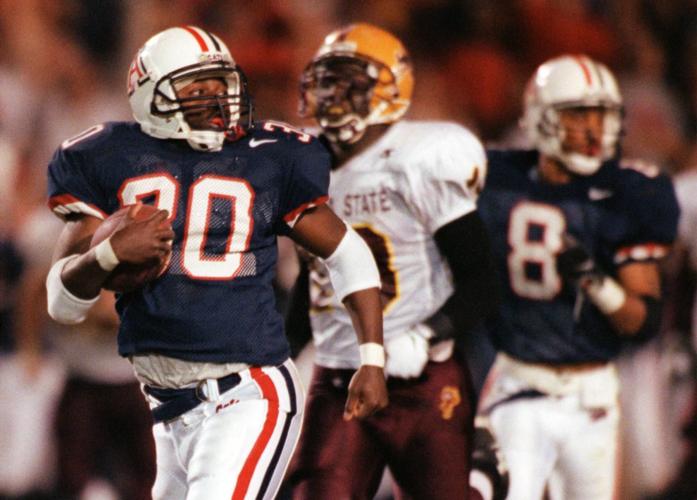Two men wearing Tournament of Roses blazers walked into an elevator bound for the УлшжжБВЅ Stadium press box. I studied their badges т Ron Okum and Bud Griest т and wrote their names into a notepad.
Okum and Griest were directed to the suite of UA athletic director Jim Livengood, who was accompanied by Pac-10 commissioner Tom Hansen.
Everyone turned to watch the Rose Bowl men as if they were from some sort of royal family. No man wearing a Rose Bowl blazer had ever stepped foot into УлшжжБВЅ Stadium.
Four hours later, after УлшжжБВЅ beat ASU 50-42 in a 1998 Territorial Cup for the ages, finishing the regular season 11-1, Okum and Griest joined Livengood and Hansen for the UAтs celebration in the cramped old locker room underneath the west grandstands.

Running back Trung Canidate bursts into the open field as he races for a touchdown in a win over УлшжжБВЅ State. Canidate, one of many star-level players on the UA offense in 1998, gained 1,220 rushing yards that season and then amassed 1,602 yards the following year.
This went beyond anything ever seen since УлшжжБВЅ began playing football 99 years earlier; beyond the Pop McKale and Button Salmon legend; beyond entry into the WAC and those unforgettable victories over Frank Kushтs Sun Devils; beyond worshipped upsets of No. 1 USC and No. 1 Washington, and even beyond the cherished тDesert Swarmт seasons.
People are also reading…
тObviously,т said UA coach Dick Tomey, тthis team is going someplace.т
Someplace was the Rose Bowl.
On the morning of Dec. 5, 1998, this newspaper published a story explaining the process to purchase Rose Bowl tickets. There would be no camping overnight in front of McKale Center. Lines would form at 6 a.m. on Monday as the UA would try to fairly distribute its allocation of 32,000 tickets.
You can imagine the scene on campus on Monday, Dec. 7, 1998, a day that wouldтve lived forever in the history of УлшжжБВЅ sports.

On Saturday morning, the UA cheerleaders caught a flight to Los Angeles and drove to the Tournament of Roses house in Pasadena. They would properly celebrate the official invitation late that afternoon.
Only one detail remained undone: 10-0 UCLA had to beat unranked Miami that afternoon; the Hurricanes were coming off a 66-13 loss to Syracuse.
People in УлшжжБВЅ held watch parties all over the town, most with a stem of roses to celebrate UCLAтs victory т and berth in the BCS playoffs т and УлшжжБВЅтs imminent spot in the Granddaddy of Them All.
And then Miami stunned the Bruins 49-45.
УлшжжБВЅ would go to the Holiday Bowl and beat No. 9 Nebraska, 23-20, to finish the season 12-1. It wasnтt the Rose Bowl, but it was The Next Best Thing, the greatest season in UA football history.
Now, looking back 20 years, I donтt remember the triumphs as much as the struggle to put that revered season into the record books.
The Wildcats entered the season as anything but a beloved part of УлшжжБВЅ sports. A year earlier, the UA averaged 40,538 at УлшжжБВЅ Stadium, which remains the lowest figure in the history of expanded УлшжжБВЅ Stadium, 1976-2017. It drew тcrowdsт of 36,309, 37,111, 39,195 and 39,754.
It didnтt take a marketing genius to realize that Tomey was about to be fired.
He saved his job in November 1997 by hanging on to beat a bad Cal team in double overtime, and by stunning heavily favored ASU, 28-16, in Tempe.
The Wildcats were predicted to finish fifth in the Pac-10 in 1998.
Two things changed the course of UA football history: Tomey had fully rebuilt his long-stodgy offense that left so many seats empty at the stadium. He made unprecedented steps to change, hiring NFL legends Bill Walsh and Dick Vermeil as consultants.
Two, unknown at the time, УлшжжБВЅтs offense was full of star-level players: future NFL receivers Dennis Northcutt and Jeremy McDaniel, NFL tight ends Mike Lucky and Brandon Manumaleuna, and record-setting tailback Trung Canidate, who would go on to gain 2,822 yards the next two seasons.

Lineman Yusuf Scott (72) gets to know Oregon linebacker Aaron Cheuvront. The Wildcats routed the Ducks 38-3 on Halloween 1998 in one of the seasonтs defining games.
Additionally, Tomey probably gathered the top defensive coaching staff in school history, adding former Hawaii head coach Bob Wagner to a group that included the cornerstones of УлшжжБВЅтs тDesert Swarmт lineage, Rich Ellerson and Duane Akina.
UA cornerback Chris McAlister, linebacker Marcus Bell and linemen Yusuf Scott and Daniel Greer were as good in 1998 as anyone in the Pac-10. Quarterback Keith Smith was a game-changer.
Memories of the т98 team always go back to the irresistible тLeap by the Lake,т quarterback Ortege Jenkinsт unforgettable summersault into the end zone to beat Washington 31-28 in the dying seconds. But more telling т the defining game of the т98 season т was a 38-3 blowout of No. 12 Oregon on Halloween.

УлшжжБВЅ assistant coach Duane Akina gives Kelvin Hunter encouragement on the sideline against the Oregon Ducks in 1998.
The УлшжжБВЅ audience was unconvinced even though УлшжжБВЅ was 7-1 and ranked 13th. Attendance was a bare 44,913.
But in the lead-up to the game, Ellerson and Akina both had memorable (and rare) flareups during a Wednesday afternoon practice. They were not screamers and name-callers. But on that afternoon, they got their teamтs attention while demanding more intensity and attention to detail. Ellerson and Akina knew what was at stake.
The Ducks didnтt have a chance on Halloween in УлшжжБВЅ.
The banner headline in Sundayтs Daily Star read: Cats So Good Itтs Scary.
And so they were.


















